Address any questions or comments regarding this newsletter to the individual authors listed after each article or to its editors, Nathan Johanning, 618-939-3434, njohann@illinois.edu or Bronwyn Aly 618-695-6060, baly@illinois.edu. The Illinois Fruit and Vegetable News is available on the web at: http://ipm.illinois.edu/ifvn/. To receive or be removed from email notification of new postings of this newsletter, contact Nathan Johanning or Bronwyn Aly at the phone numbers or email addresses above.
In This Issue:
Upcoming Programs (listings for beginning and established growers)
News & Announcements (PSA Grower Training Courses Available During COVID-19, New Local Food Systems & Small Farms Educator Serving Lake & McHenry Counties, USDA to Provide Additional Direct Assistance to Farmers and Ranchers Impacted by the Coronavirus)
Regional Reports (St. Louis metro east, southwestern Illinois (Waterloo), southern Illinois (Murphysboro), Dixon Springs)
Fruit & Vegetable Production & Pest Management (Pumpkin Field Day Recordings and Resources, Cross-Striped Cabbage Worm on Collard, Brussels Sprouts, Broccoli)
Upcoming Programs
See the University of Illinois Extension Local Food Systems and Small Farms Team’s website at:
http://web.extension.illinois.edu/smallfarm/ and the calendar of events at http://web.extension.illinois.edu/units/calendar.cfm?UnitID=629.
- Midwest Mechanical Weed Control Field Day. Each virtual session will be streamed online through Facebook Live from 12:30pm to 1:15pm on the following Fridays in September:
September 11 — Episode 1: Drone Wars, an exploration of camera-guided cultivation in row crops
September 18 — Episode 2: The Awakening, a demonstration of tool set-up and in-shop adjustments
September 25 — Episode 3: The First Encounter, precision cultivation in direct-seeded vegetables
To register and find additional information, including an overview of the tools being demonstrated, please visit https://thelandconnection.org/event/mwc-2020/.
- 2021 Illinois Specialty Crops Conference, January 6-8, 2021. Save the dates and be on the lookout for information coming soon about this year’s virtual conference!
News & Announcements
PSA Grower Training Courses Available During COVID-19

When measures to control COVID-19 went into effect across the United States and other countries, the PSA team moved quickly to ensure growers would have access to required produce safety training. The PSA team fast-tracked an Online PSA Grower Training course option and a Temporary Remote Delivery course option. Both successfully launched in April 2020. Now, in addition to in-person courses that continue to be available at some locations, fresh produce growers and packers have access to the course via the internet in two different formats. The Online option is best for those who need to work at their own pace, and that have more time to invest. The Online PSA Grower Training is text heavy and requires participants to write six discussions for evaluation by a PSA Trainer. The Remote Delivery option is best for those who have blocks of time available and prefer to listen to a PSA Trainer deliver the content as live presentations over the internet. Full details of these two course options are in the linked descriptions. Search our Upcoming Grower Trainings listing for a course that meets your training needs or talk to your local produce safety outreach team member about their plans to offer the course in the coming months.
Laurie George (618-548-1446; ljgeorge@illinois.edu)
New Local Food Systems & Small Farms Educator Serving Lake & McHenry Counties

We would like to welcome the newest member to the University of Illinois Extension Local Food Systems & Small Farms team, Sarah Farley. Sarah is serving as the Local Food Systems and Small Farms Extension Educator in Lake and McHenry Counties. In her role, she works to develop and deliver research-based programs to growers, collaborate with community partners, and extend University resources to meet the needs of those involved in the local food system. Sarah comes to the University of Illinois Extension with a myriad of professional experience including livestock and crop production, sales and marketing, agriculture entrepreneurship, risk management, positive youth development, and farm financial management.
Originally from Pennsylvania, Sarah Farley earned a B.S. in Animal Sciences, Agribusiness Management at Penn State University and a M.S. in Agriculture and Life Sciences from Virginia Tech.
Sarah encourages individuals to contact her with questions related to their small farm enterprise or food system project. She can be reached by e-mail at sfarley@illinois.edu or at one of her two office numbers 847-223-8627 (Lake County) / 815-338-3737 (McHenry County).
USDA to Provide Additional Direct Assistance to Farmers and Ranchers Impacted by the Coronavirus
President Donald J. Trump and U.S. Secretary of Agriculture Sonny Perdue today (09/18/20) announced up to an additional $14 billion dollars for agricultural producers who continue to face market disruptions and associated costs because of COVID-19. Signup will begin September 21 and run through December 11, 2020, for this next round of Coronavirus Food Assistance Program payments (CFAP 2).
Producers whose agricultural operation has been impacted by the pandemic since April 2020 are encouraged to apply for CFAP 2. Payments will be made for three categories of commodities: Price Trigger Commodities, Flat-rate Crops and Sales Commodities.
Specialty crops are included in the Sales Commodities category, which also includes aquaculture, nursery crops and floriculture and other commodities not included in the price trigger and flat-rate categories. Payment calculations will use a sales-based approach, where producers are paid based on five payment gradations associated with their 2019 sales. Flat-rate Crops include hemp.
A complete list of eligible commodities, payment rates and calculations are available on farmers.gov/cfap.
More information about CFAP 2 can be found here: https://www.usda.gov/media/press-releases/2020/09/18/usda-provide-additional-direct-assistance-farmers-and-ranchers
Regional Reports
From the St. Louis Metro east… The region has dried significantly since receiving well above average rainfall the 2nd week of August. Temperatures and humidity are just starting to drop, giving the air that first taste of coming fall weather. Some initial corn fields have been opened up, in preparation for the major push. Plasticulture strawberries have been planted and sweet corn harvest has come to a close. Tomatoes, cucumbers, zucchini and peppers are still in harvest. The pumpkin crop is in the final ripening stage and harvest has begun. Apples currently in harvest include Pixie Crunch, Golden Delicious, and Red Delicious. Harvest of Honeycrisp, Jonathon, and Gala are completed but still available on local markets. Yet to be harvested are cultivars like Granny Smith, Fuji, EverCrisp and Suncrisp. Fall u-pick activities are ramping up around COVID-19 restrictions. Region 4 (Madison, St Clair, Monroe, Randolph, Bond, Clinton and Perry) under Restore Illinois https://dceocovid19resources.com/restore-illinois is currently under additional, more restrictive mitigation measures until the region drops below an 8% positivity rating for 3 consecutive days. On the positive side, consumer demand remains high and agritourism/agritainment businesses are working within the guidelines to offer customers the best experience harvesting local produce.
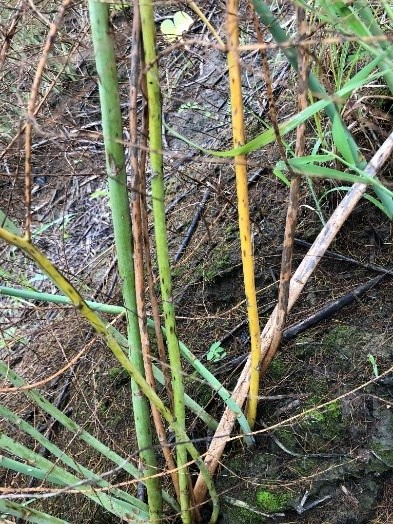
Asparagus growers should be on the lookout for early senescence of ferns that may be due to purple spot. Areas that have experienced wet and windy weather like the St Louis Metro East are more prone to disease spread. Hot, dry conditions in July and August will slow the progression of this disease, however levels of infection can increase dramatically as the temperatures cool in early fall. As the disease spreads, the lesions expand and merge together killing the affected tissue and eventually causing wide-spread premature defoliation, which will decrease carbohydrate reserves and yield for the next production season. Controlling purple spot begins with preventative fungicide applications during summer and fall by reducing infections to ferns and stalks. Fungicide options are available in the Midwest Vegetable Production Guide for Commercial Growers https://www.extension.purdue.edu/extmedia/ID/ID-56-W%202020.pdf
Elizabeth Wahle (618-344-4230; wahle@illinois.edu)
From southwestern Illinois (Waterloo)… We have been sunny and dry in southern Illinois. About a week ago some areas to the south did get some rain (0.9” at our farm in southern Monroe Co. but nothing once you got north up to Waterloo). Temperatures have been mild with highs in the 70s to low 80s for the most part and lows down to the low 50s. While it is very dry, most crops are fairing well especially with the more mild temperatures. Grain and pumpkin harvest is greatly benefiting from the dry weather. There are a few small rain chances but overall more of the same is in the forecast for the area. Some things would benefit from some rain, but personally I appreciate the sun and dry especially during harvest! I will take it for as long as I can get it.
Most summer vegetables are still in full harvest, however all of the rain earlier in the summer has been hard on them and many have abandoned plantings for the season. With the drier weather and sun, late plantings look good if you caught a timely rain or have irrigation. Our fruit quality tomatoes in research trials at near Waterloo looks better now than it has all season despite lots of early blight on foliage and decreasing yields as we are now nearing 6 weeks of harvest on determinate tomatoes.

‘Karisma’ bell peppers after trial harvest on research investigating different tillage and cover crop systems Photo: N. Johanning
The variety is ‘Red Deuce.’ Fruit size all along has been very good (most over 0.5 lb) and now the cracking and rot is far lower. At its worse in a plot almost half of the harvested fruit would be culls and now it was down below 20% of the fruit in the last harvest. The indirect effect on quality is we are more prone to let the tomatoes almost fully ripen on the vine giving even better flavor compared with the wet period when we would harvest a little less ripe and let them set just to avoid at least some of the cracking and rot.
We made our final harvest for data collection on the peppers in our tillage/no-till/cover crop trial for tomatoes and peppers. I mentioned the tomatoes above, but the pepper variety was ‘Karisma.’ I was very impressed with the performance of the variety. It had very good size (many very large, “fancy” grade), shape and color. It stayed fairly short in stature, setting many fruit down on low nodes. While we did tie them just a little they supported themselves fairly well. They are a green to red pepper and while a great variety for green, they did not hold up well to full turn red, at least for us this year, without having some spot or other issue. Overall a variety I would recommend. Stay tuned for more trial details as we get the harvest data complied!
Apples are in full harvest and there are still a few stray “very late” peach varieties that can be found. Pumpkin harvest is well under way. Downy mildew has been observed in various areas throughout southern Illinois. The continued wet we had back in August was a main contributor along with the presence of the disease. I have observed downy mildew at our pumpkin trials at Belleville and also at my own farm south of Waterloo. We have been managing with some of the newer systemic fungicides recommended and it seems to be holding it in place preventing further spread. The dry weather is also helping keep the disease at bay as well. These systemic products can be a little higher in price but are effective and many have a very short preharvest interval. Note to look at use rates and figure how much you are paying ‘per acre’ rather than per jug. This takes some added time, but can be very eye opening and helpful. Personally the fruit set we had was a little later and I still have ripening fruit that will be ready for marketing in October so I did not want to let the disease go un attended. I have had experience with fairly bad downy mildew one other year and it really haulted the plants and limited any further fruit set. Also, I have observed that there are differening levels of “tolerance” to the disease between different varieties. From my field observations varieties such as Jack-be-Little and Baby Boo, followed by Autumn Wings and Gizmo were some of the first to show sypmtoms and defoliation. Warty Goblin and Spector did show some and most other Jack-o-Lantern and specialty varieties were a little later to show any infection. What I learned from this was not necessarily not to plant these varieties as this disease is not an annual event but rather, if the disease is present those varieties are my first priority to spray and protect from this disease. Note that there was not any variety that I could not find signs of the disease; all are susceptible, but certainly it can hit some before and faster than others. Check out the downy mildew article in the last issue, 26:8 (https://ipm.illinois.edu/ifvn/contents.php?id=160) for more details on disease management.
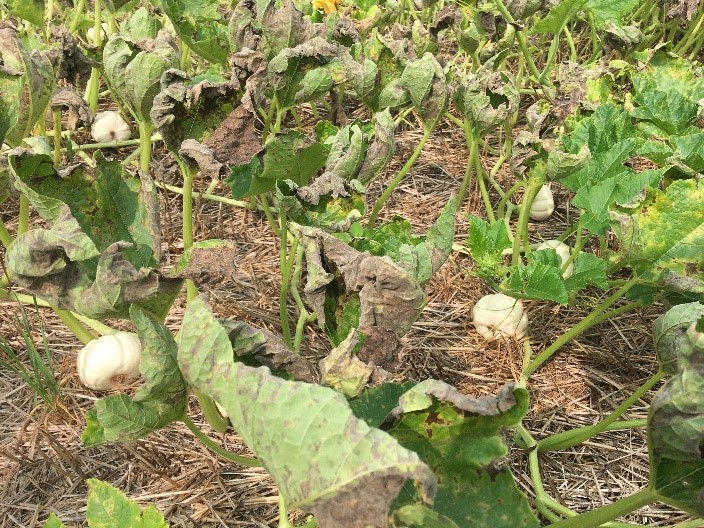
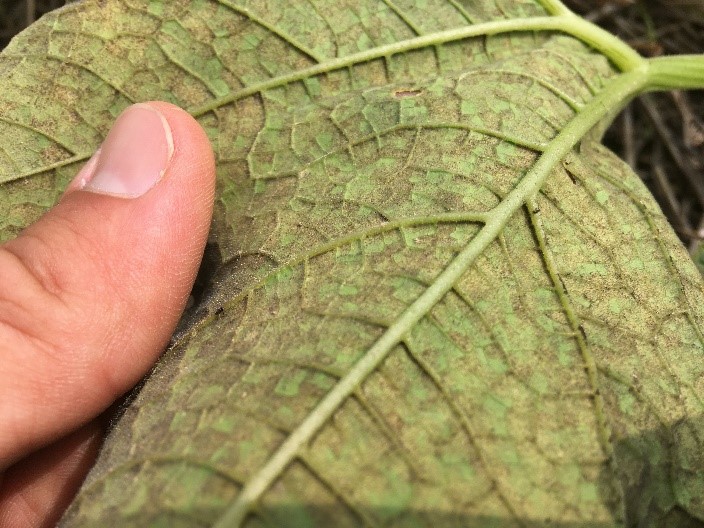
Downy mildew on ‘Baby Boo’ mini pumpkin (top left). Disease infection on the underside of the leaf. Note the black tint from the disease. (top right) Looking out across the field you can see differences in defoliation based on variety. (bottom) Photos: N. Johanning
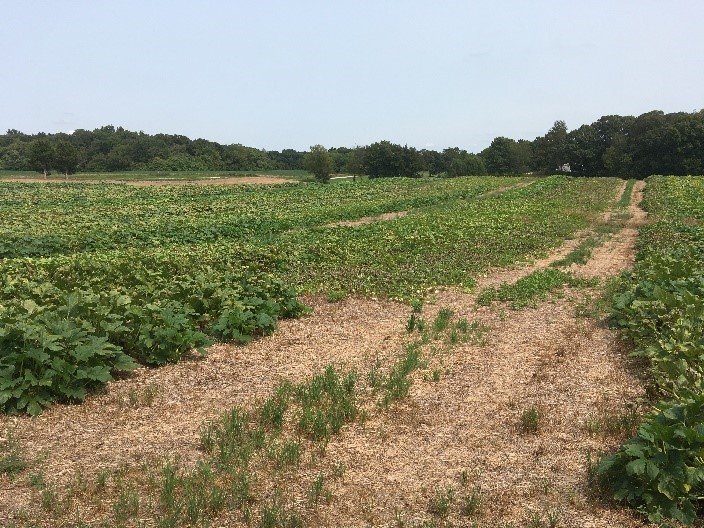
From everyone I have talked to and my observations fall markets are very busy. Where I have been folks have been very good about keeping their distance, wearing masking, and being respectful of others. I hope this will be another “bright spot” for our industry and support not only this season, but start forming long term habits of consumers directly supporting our local farms.
Now is the time to start thinking about cover crop planting! As areas come out of production take a little time to clean them up and seed a cover crop. The Midwest Cover Crop Council has just updated their “cover crop selector tool” which can help wade through the challenges of picking the best cover crop for your goals and also seeding rates. Check out the tool at www.mccc.msu.edu. Note we just have the tool for “agronomic crops” for now in Illinois however a cover crop is a cover crop weather you have corn or tomatoes. In our area early cover crop plantings have been off to a slow start with the lack of moisture. We do have some oats and crimson clover planted at home. It is trying to come up but the lack of moisture is slowing it down.
Nathan Johanning (618-939-3434; njohann@illinois.edu)
From southern Illinois (Murphysboro)… This week we are finally getting some relief from the summer heat. Days have been in the high 70’s and low 80’s while being much less humid, and nights have been as cool as 59. At the Murphysboro office, the tomato trial is finished with a total of 7 harvests. The high tunnel is currently being transitioned into cool season production. In late August, lettuce, spinach, swiss chard, and kale were started in cell trays. Carrots, beets, radishes, and parsnips were planted in the raised beds. Three varieties of carrots were planted in the high tunnel in both tilled and untilled soil after tomatoes. This spring, artichokes were transplanted in the high tunnel and the first buds were harvested last week. The buds were a little small but have good flavor when cooked. The artichokes will be overwintered in the high tunnel using row covers.

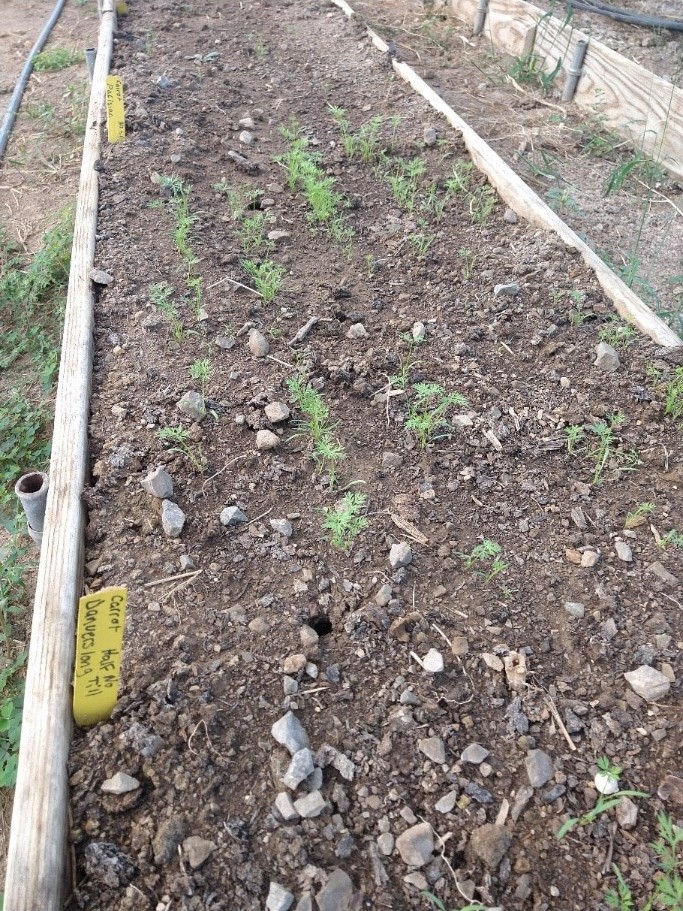
Left to Right: Transplants set in late August for fall/winter greens harvest and direct seeded carrots, both in high tunnel at Jackson Co. Extension office. Photos by K. Bell.
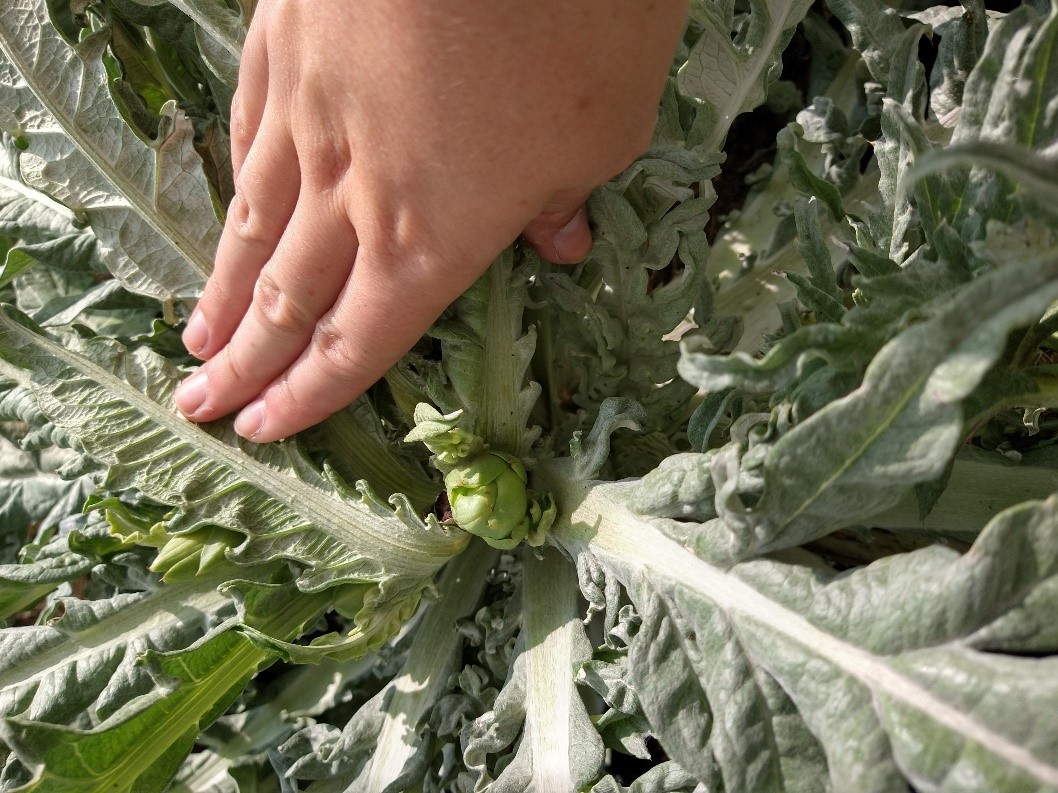
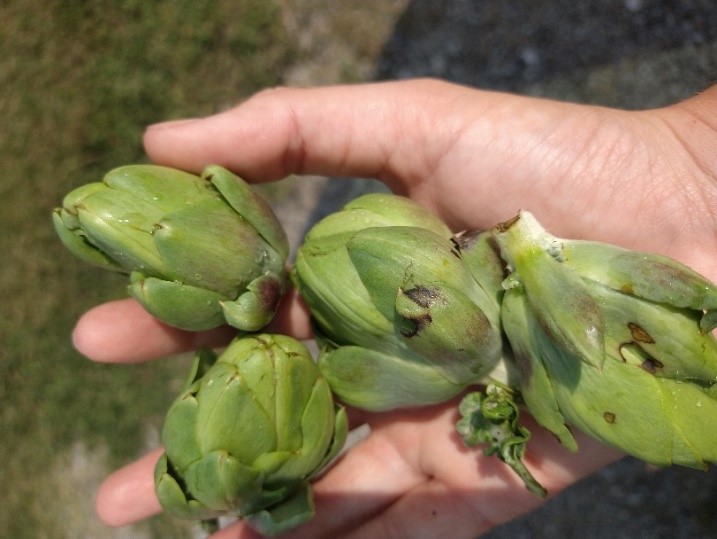
Artichokes transplanted this past spring were harvested the middle of September from the Jackson Co Extension office high tunnel. Photos by K. Bell.
Katie Bell (618-687-1727; klbell@illinois.edu)
From Dixon Springs Ag Center…The lower humidity and cooler temps over the past few days, and continuing in the forecast for the next several days, is a welcome sign of the changing of the season. As warm season summer crops are winding down, transplants and direct seeded plantings for fall and winter markets should be well underway. We are moving further along with our plantings in the high tunnel that are included in year 2 of our Illinois Specialty Crop Block Grant, Utilizing High Tunnels to Maximize Winter Vegetable Production. Carrots have been direct seeded on Aug 7 and Sept 8, with the next couple of planned seeding dates on Sept 22 and Oct 6. The first plant date for kale, spinach, and head lettuce transplants was Sept 8. Like last year, transplants were set into two permanent raised beds, one bed with black plastic mulch stretched over the top and the other without plastic mulch. Some plots will receive a row cover over the top, if temperatures reach 25 degrees F or below, and the other half will have no protection from cold weather.
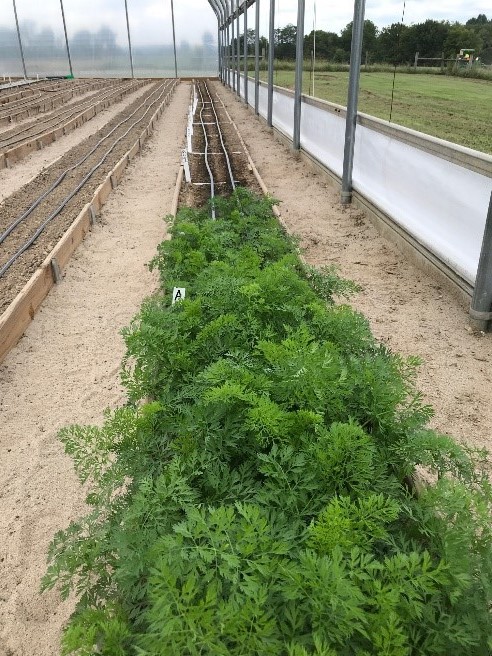
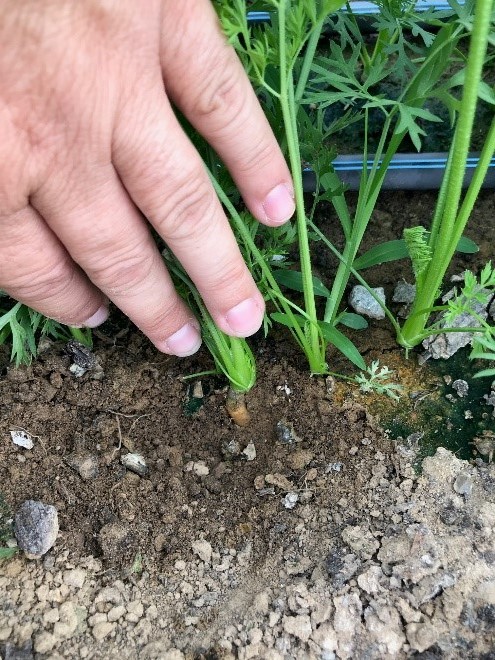
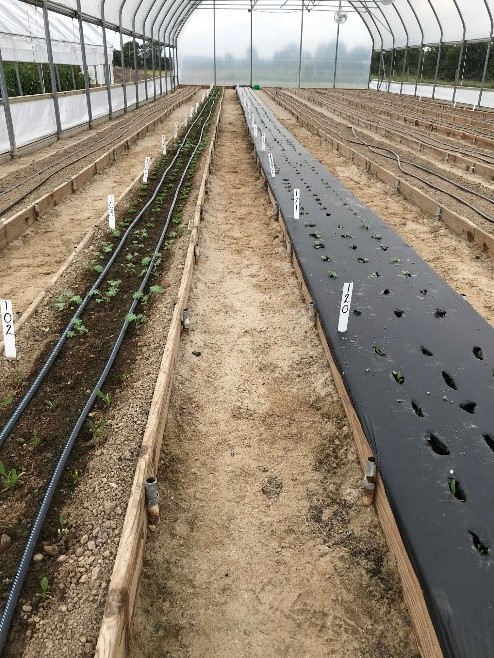
Left to right: Aug 7 seeded carrots in the foreground and Sept 8 seeded carrots further down the row. The Sept seeded carrots have mostly all germinated and are starting to put on first and second true leaves. The Aug seeded carrots are starting to show a bit of sizing on the root but still need time to size to reach the desired 3/4” – 1” diameter. Sept 8 planted transplanted of kale, spinach, and green head lettuce on both bare ground and black plastic mulch beds. All beds in this trial received 60 lbs/acre of nitrogen in the form of Urea (46-0-0) broadcast pre-plant and incorporated. Also, all beds have two lines of drip tape with 4” emitter spacing. All photos by B. Aly.
I wanted to share a few observations I have made regarding the hydroponic raspberries we have growing in our high tunnel at DSAC. We have two black raspberry varieties, ‘Bristol’ and ‘Niwot’, with ‘Niwot’ being a primocane fruiting type. So far I have not seen any signs of flower set on ‘Niwot’ but it is a bit more vigorous than ‘Bristol’ with much sturdier laterally branching. The lateral branching on ‘Bristol’ has been pretty brittle, with many breaking over at the main stem attachment point. The following pictures will hopefully demonstrate the training systems we are looking at on these plants, but from a pruning standpoint, on both black raspberry varieties, I have now tipped the main canes and tipped the laterals that were forced from the main cane tipping. This needed to be done as the lateral branches were hitting the floor of the tunnel and I did not want them to start to root in the gravel. Also, both varieties are very thorny. ‘Double Gold’ is a fall raspberry that has a nice champagne blush color. It is also thorny but with somewhat softer thorns, if that is possible. This variety is not as vigorous as the two black raspberries but it is producing several new canes from the root system. It has started to set a fair amount of flowers and I have done a bit of tipping on a few of the main canes to see if I can get more fruit set/cane off of lateral branches. The last variety that we have is ‘Joan J’, a thornless red raspberry. This variety has been setting a lot of flowers in the past couple of weeks and appears to be the least vigorous of all the varieties so far. The fruit has excellent quality and flavor, and when ripe, pulls off easily. The canes tend to want to throw a few lateral branches naturally early on without tipping, with cane height of about 4 feet at fruit set, and a few new canes have started to emerge from the root system.
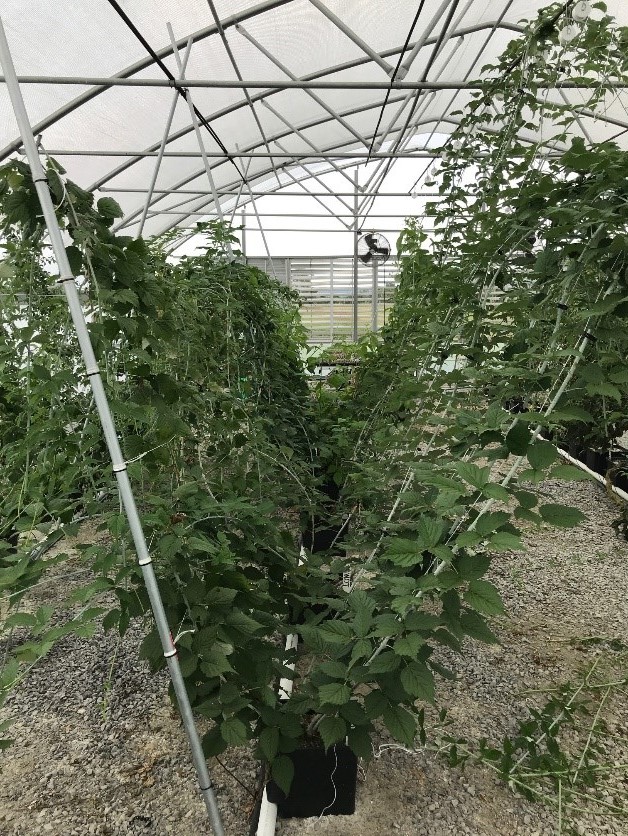

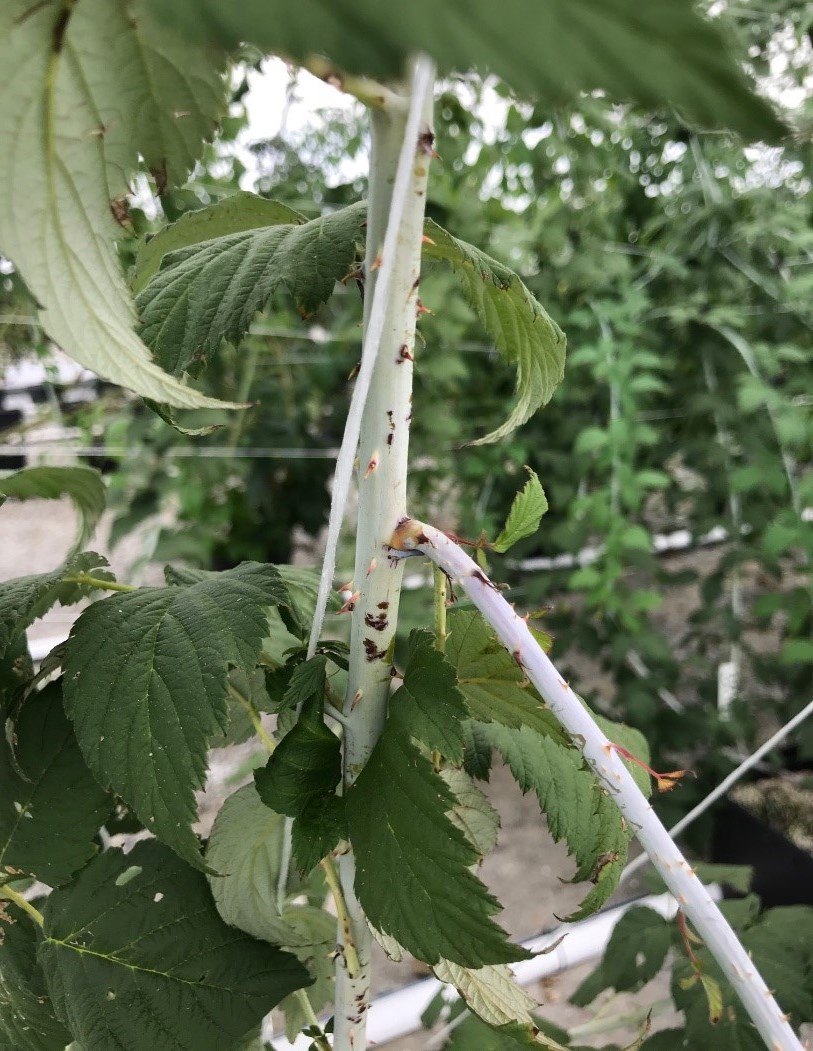
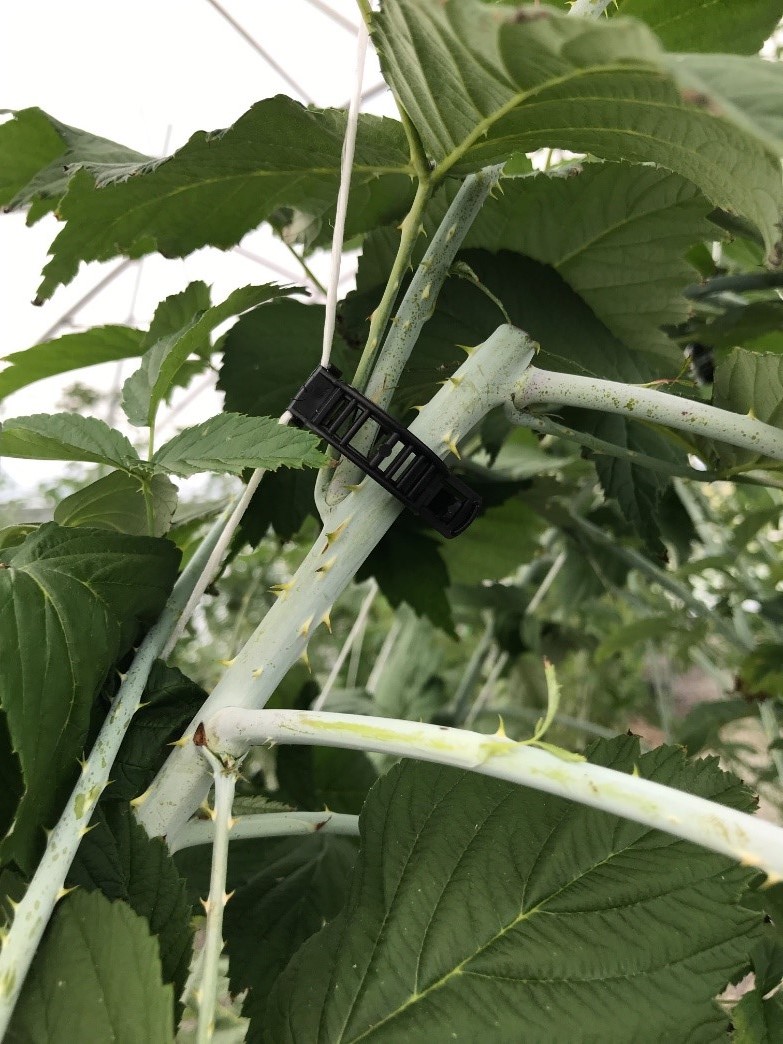
Top left: Hydroponic raspberries being trained to an open V in two different ways,one side training canes up a single trellis string and the other side clipping canes to horizontal strings going up, top right:‘Niwot’ laterals forming a curtain effect, bottom right: strong, sturdy ‘Niwot’ canes and laterals, bottom left: weak ‘Bristol’ laterals. All photos by B. Aly.
I will continue to put in a plug for our Illinois Extension Local Foods & Small Farms YouTube channel, Illinois LocalFoods Video content is continuing to be added to the channel weekly, with content being organized into playlists based on subject matter or specific vlog locations, including Local Food Happenings at DSAC , The Urban Ag Connect Vlog Series and the Beginning Food Production Resources. The most recent additions include videos discussing pumpkin disease management and the virtual tour from Pumpkin Field Day held last week. Check it out and subscribe today!
Bronwyn Aly (618-382-2662; baly@illinois.edu)
Fruit & Vegetable Production & Pest Management
Pumpkin Field Day Recordings and Resources
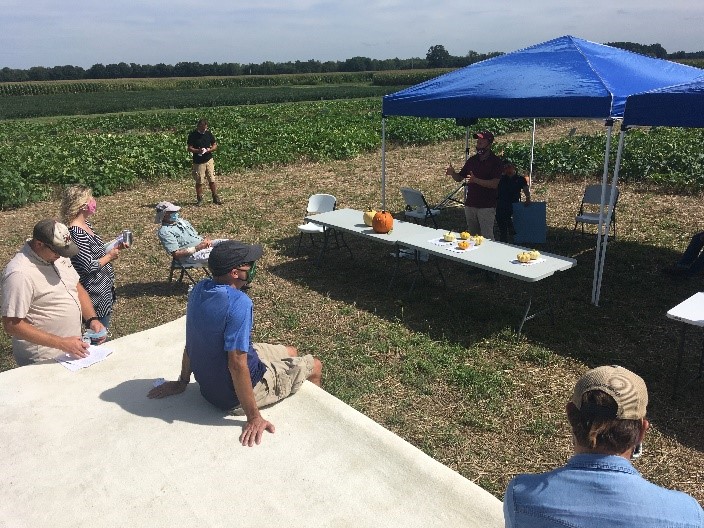
Thank you to all who attended our Pumpkin Field Day on September 3rd both in-person and virtually. We had around 30 people across the day in-person and over 60 attend the live broadcast at noon. Thank you also to our presenters and my fellow staff that helped make all of this possible!
Below are some links to some recording and information we have now. We will be recording more, especially on the variety trial as we collect harvest data in the next few weeks.
Most of these video resources will all be found on a “2020 Pumpkin Research and Field Day” Playlist on the Illinois Local Foods YouTube Channel.
Virtual Pumpkin Field Day Recording https://youtu.be/d8PVS6mf7uk
Disease Management Recordings from Dr. Mohammad Babadoost:
Powdery Mildew Management in Pumpkins https://youtu.be/SfCgR5DXohM
Downy Mildew Management in Pumpkins https://youtu.be/gL5tiSUspmA
Bacterial Spot Management in Pumpkins https://youtu.be/RGz0q6LsE9k
Phytophthora Blight Management in Pumpkins https://youtu.be/OfGPRwDah3g
Also here is the contact information for the other presenters for field day:
Mohammad Babadoost, Extension Specialist, University of Illinois babadoos@illinois.edu; 217-333-1523
Kacie Athey, Extension Entomologist, University of Illinois kathey@illinois.edu; 859-433-8364
Alan Walters, Professor -Vegetable Production, Southern Illinois University Carbondale awalters@siu.edu; 618-453-3446
Lindsey Orphan, Graduate Student, Vegetable Production, Southern Illinois University Carbondale lindseyorphan@siu.edu
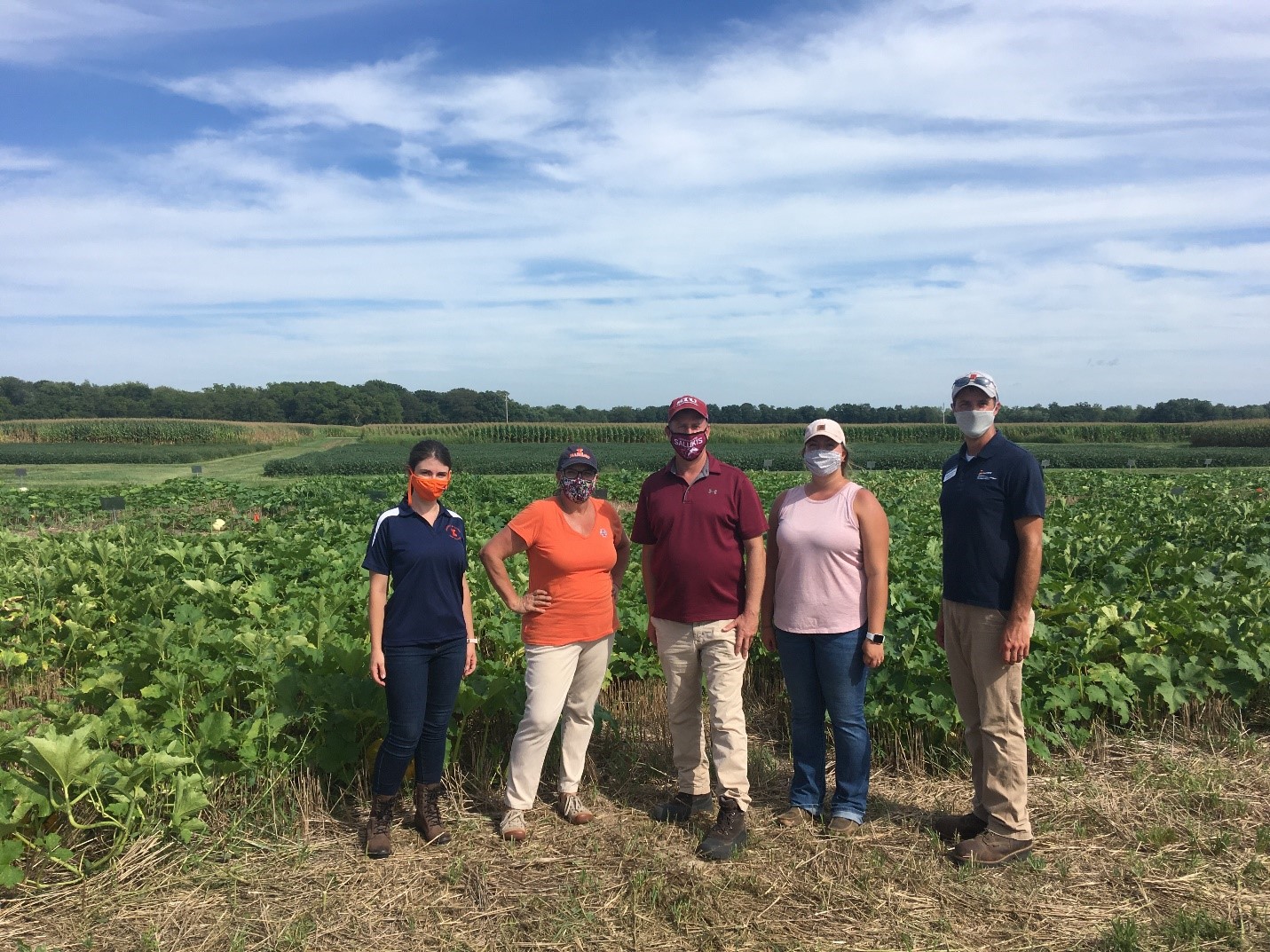
Pumpkin Field Day staff/presenters, Kacey Athey, Elizabeth Wahle, Alan Walters, Lindsey Orphan and Nathan Johanning Photo: R. Baechle
Nathan Johanning (618-939-3434; njohann@illinois.edu)
Cross-Striped Cabbage Worm on Collard, Brussels Sprouts, Broccoli
Cross-striped cabbageworm (Evergestis rimosalis) feeds on leaves and in heads of cabbage family plants, reducing yields and marketability. Because moths of this species lay eggs in clumps or masses, worms and damage may be heavy on an individual plant and completely absent a few plants away. The same insecticides used to control other "worms" in these crops (Bt against young larvae, Coragen, Radiant, and pyrethroids) are also effective against cross-striped cabbageworm (IFVN, 24:15, 2018). See the 2020 Midwest Vegetable Production Guide for a more complete listing of insecticides by crop; be sure to obey pre-harvest intervals where harvests are coming up or ongoing.
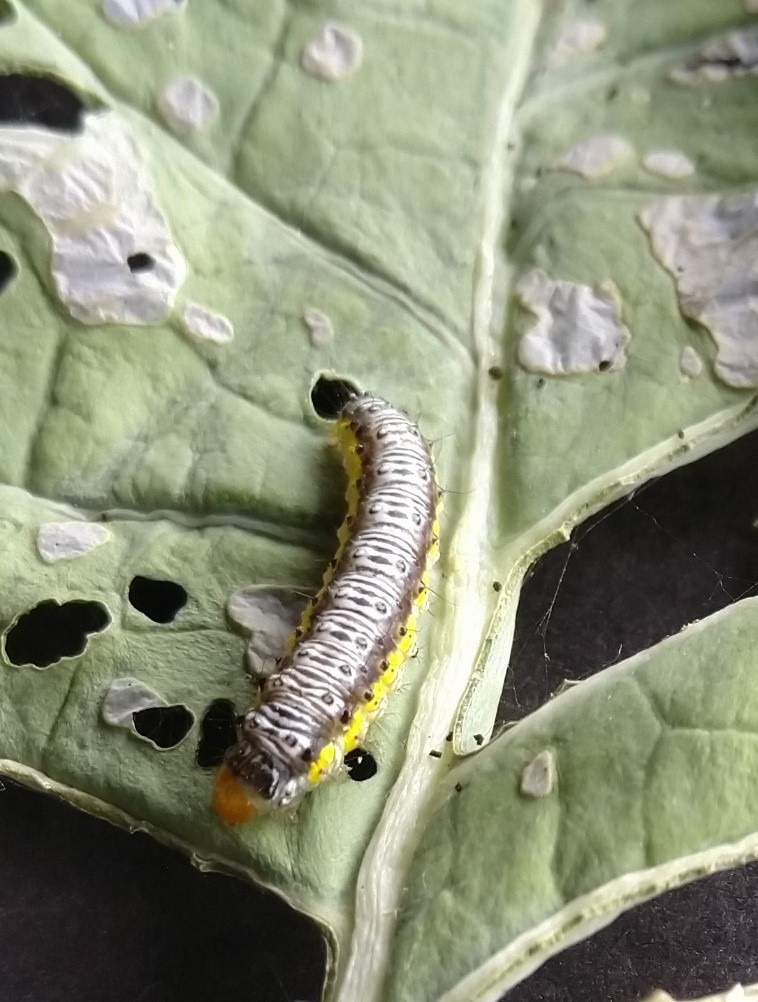
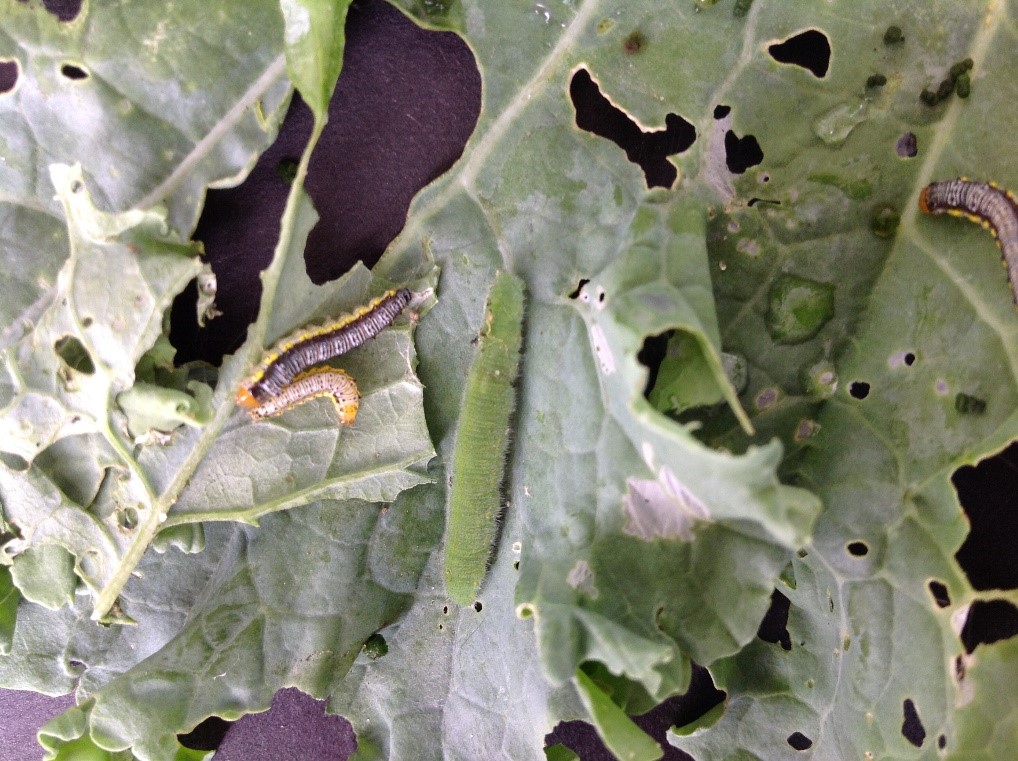
Left: Cross-striped cabbageworm Right: Cross-striped cabbageworm and imported cabbageworm
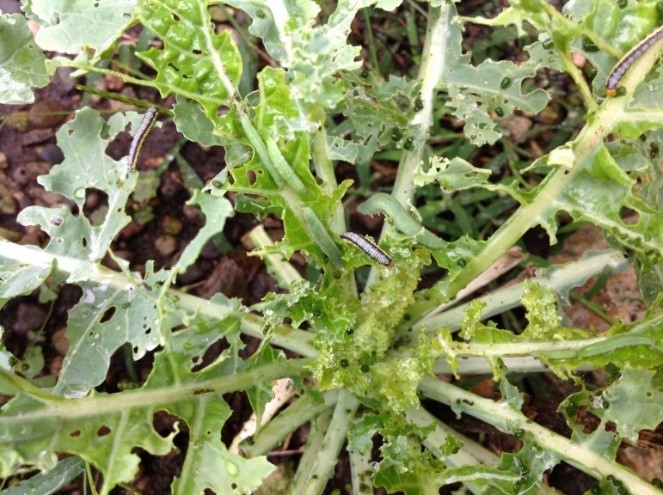
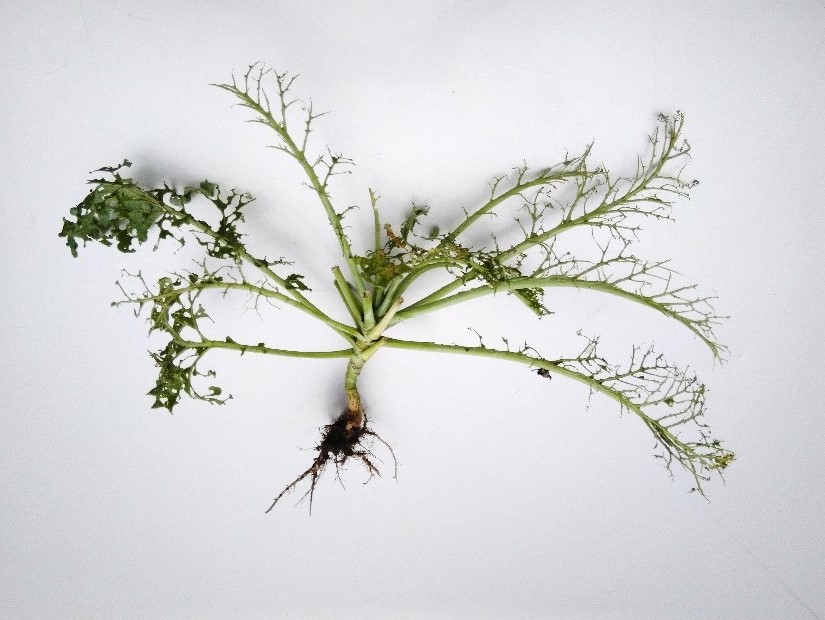
Collard plants stripped bare by cross-striped and imported cabbage worms. All images by J. Theuri.
James Theuri (815-933-8337; jtheu50@illinois.edu)
Less Seriously
This seemed like a good time for a few motivational quotes to keep everyone inspired through the busy fall season. You are about to turn the September corner and head into Pumpkin Spice October, have fun!!!
https://everydaypower.com/funny-motivational-quotes-about-life/
“Don’t worry about the world coming to an end today. It is already tomorrow in Australia.” – Charles Schulz
“The best way to cheer yourself up is to try to cheer somebody else up.” – Mark Twain
“We don’t stop playing because we grow old; we grow old because we stop playing.” – George Bernard Shaw
“Friendship is like peeing on yourself: everyone can see it, but only you get the warm feeling that it brings.” – Robert Bloch
“If you think you are too small to be effective, you have never been in the dark with a mosquito.” – Betty Reese
“A bank is a place that will lend you money if you can prove that you don’t need it.”– Bob Hope
“Think left and think right and think low and think high. Oh, the thinks you can think up if only you try!”
– Dr. Seuss
“Never let your sense of morals prevent you from doing what is right.” – Isaac Asimov
“Opportunity does not knock, it presents itself when you beat down the door.” – Kyle Chandler
University of Illinois Extension Specialists in Fruit and Vegetable Production & Pest Management
Extension Educators – Local Food Systems and Small Farms |
||
Bronwyn Aly, Gallatin, Hamilton, Hardin, Pope, Saline, and White counties |
618-382-2662 |
|
Katie Bell, Franklin, Jackson, Perry, Randolph, & Williamson counties |
618-687-1727 |
|
Sarah Farley, Lake & McHenry counties |
847-223-8627 |
|
Nick Frillman, Woodford, Livingston, & McLean counties |
309-663-8306 |
|
Laurie George, Bond, Clinton, Jefferson, Marion, & Washington counties |
618-548-1446 |
|
Zachary Grant, Cook County | 708-679-6889 | |
Doug Gucker, DeWitt, Macon, and Piatt counties |
217-877-6042 |
|
Erin Harper, Champaign, Ford, Iroquois, and Vermillion counties |
217-333-7672 |
|
Grace Margherio, Jackie Joyner-Kersee Center, St. Clair County |
217-244-3547 |
|
Grant McCarty, Jo Daviess, Stephenson, and Winnebago counties |
815-235-4125 |
|
Katie Parker, Adams, Brown, Hancock, Pike and Schuyler counties |
217-223-8380 |
|
Kathryn Pereira, Cook County |
773-233-2900 |
|
James Theuri, Grundy, Kankakee, and Will counties |
815-933-8337 |
|
Extension Educators – Horticulture |
||
Chris Enroth, Henderson, Knox, McDonough, and Warren counties |
309-837-3939 |
|
Richard Hentschel, DuPage, Kane, and Kendall counties |
630-584-6166 |
|
Andrew Holsinger, Christian, Jersey, Macoupin, & Montgomery counties |
217-532-3941 |
|
Extension Educators - Commercial Agriculture |
||
Elizabeth Wahle, Fruit & Vegetable Production |
618-344-4230 |
|
Nathan Johanning, Madison, Monroe & St. Clair counties |
618-939-3434 |
|
Campus-based Extension Specialists |
||
Kacie Athey, Entomology |
217-244-9916 |
|
Mohammad Babadoost, Plant Pathology |
217-333-1523 |
|